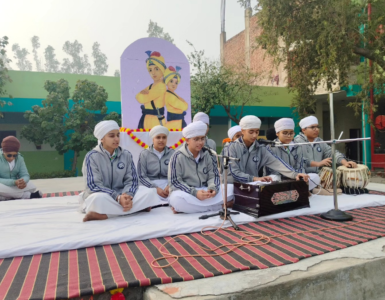Guru Hargobind Sahib Ji – The Architect of Miri Piri in Sikhism
Guru Hargobind Sahib Ji, the sixth Sikh Guru, revolutionized Sikh philosophy by introducing the concept of Miri Piri and Sant Sipahi (Saint-Soldier). Under his leadership, Sikhism evolved into a faith that emphasized both spiritual and physical strength, guiding Sikhs to achieve victory in both inner and outer battles.
Birth & Early Life of Guru Hargobind Sahib Ji
Guru Hargobind Sahib Ji was born on 19th June 1595 at Guru ki Wadali in Amritsar. He was the only son of Guru Arjan Dev Ji and Mata Ganga Ji. Understanding the need for Sikhs to defend themselves against oppression, Guru Arjan Dev Ji ensured that his son was well-trained in martial arts, weaponry, horse riding, politics, and spirituality under the guidance of Baba Buddha Ji.
Becoming the Sixth Sikh Guru
At the young age of 11, Guru Hargobind Sahib Ji took over the leadership of the Sikh community after the martyrdom of Guru Arjan Dev Ji in Lahore. He transformed the Sikh nation, instilling courage and strength among his followers. To symbolize the dual responsibility of a Sikh as both a spiritual guide and a warrior, he wore two swords—one representing Miri (temporal power) and the other Piri (spiritual authority).
Introduction of Miri Piri & the Concept of Sant Sipahi
Guru Hargobind Sahib Ji emphasized that Sikhs should be both warriors and saints. While they practiced Simran (meditation), they should also be physically strong to stand against injustice. He encouraged Sikhs to practice martial arts and weaponry while remaining spiritually connected to Waheguru.
Guru Hargobind Sahib Ji & the Establishment of Akal Takht
To strengthen the Sikh community politically, Guru Sahib founded the Akal Takht (The Throne of the Timeless One) in front of Harmandir Sahib (Golden Temple). This became the center for Sikh political and military decisions, marking a significant milestone in Sikh history.
Jailing at Gwalior Fort & Bandi Chhor Diwas
Guru Hargobind Sahib Ji’s rising influence alarmed the Mughal Emperor Jahangir, who imprisoned him in Gwalior Fort. While in captivity, he met 52 Rajput Hindu kings, who were also imprisoned. Due to his noble efforts and the intervention of Sufi saints like Sai Mia Mir and Nizamuddin Auliya, Guru Sahib was released in 1612, bringing all 52 rulers with him. This event is commemorated as Bandi Chhor Diwas, a festival coinciding with Diwali in Sikh tradition.
Guru Hargobind Sahib Ji’s Battles Against the Mughals
Guru Sahib fought four battles against the oppressive Mughal forces and emerged victorious in all. He continued to spread the teachings of Sikhism while ensuring the protection of his people from tyranny.
Guru Sahib’s Wisdom & Influence
During his travels, Guru Sahib met Pir Shah Daula, who asked him four deep questions:
- Aurat kya aur faqiri kya? (What is woman and what is spirituality?)
- Hindu kya aur Piri kya? (What is Hinduism and what is divine leadership?)
- Puttar kya vairag kya? (What is a son and what is renunciation?)
- Daulat kya or tyag kya? (What is wealth and what is sacrifice?)
Guru Sahib’s profound reply was:
“Aurat Iman, daulat guzran, puttar nishan, faqir na Hindu na Musalman.”
(A woman is faith, wealth is temporary, a son is a legacy, and a saint is neither Hindu nor Muslim.)
Establishing Kiratpur Sahib & Final Years
In his later years, Guru Sahib established Kiratpur Sahib, a spiritual town, and continued preaching Sikhism. Before merging with the Divine Light on 3rd March 1644, he passed on the Guruship to Guru Har Rai Ji, ensuring that Sikhism remained on the righteous path.
Guru Hargobind Sahib Ji’s Legacy – The Eternal Sant Sipahi
Guru Hargobind Sahib Ji’s legacy continues to inspire Sikhs worldwide. He transformed Sikhism from a passive faith into a powerful spiritual force capable of defending justice. His Sant Sipahi philosophy teaches that a Sikh must be both:
- A Saint (Sant): Always meditating on Waheguru’s virtues and leading a life of truth and morality.
- A Warrior (Sipahi): Always ready to protect human rights and stand against injustice.
Guru Hargobind Sahib Ji remains a symbol of strength, courage, and humility, shaping Sikhism into the powerful faith it is today.
















Add comment